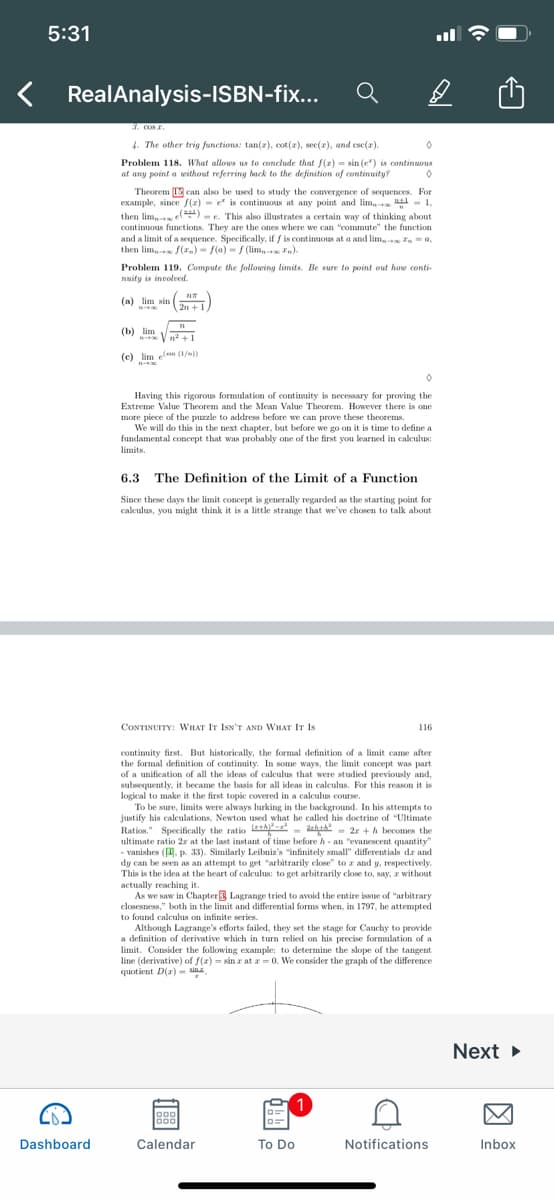Problem 119. Compute the following limits. Be sure to point out how conti- nuity is inroleed (a) lim sin 2n
Problem 119. Compute the following limits. Be sure to point out how conti- nuity is inroleed (a) lim sin 2n
Advanced Engineering Mathematics
10th Edition
ISBN:9780470458365
Author:Erwin Kreyszig
Publisher:Erwin Kreyszig
Chapter2: Second-order Linear Odes
Section: Chapter Questions
Problem 1RQ
Related questions
Question
100%
#119 part a

Transcribed Image Text:2n +
5:31
ll
RealAnalysis-ISBN-fix...
3. cosr.
4. The other trig functions: tan(z), cot(z), sec(r), and ese(r).
Problem 118. What allows us to conclude that S(z) = sin (e") is continuous
at any point a without referring back to the definition of continuity?
Theorem (I can also be used to study the convergence of sequences. For
example, since f(z) - e is contimuous at any point and lim, - 1,
then lim e )-e. This also illustrates a certain way of thinking about
contimuous functions. They are the ones where we can "commute" the function
and a limit of a sequence. Specifically, if f is continIous at a and lim, In =a,
then lim, () - f(a) - f (lim Fn).
Problem 119. Compute the following limits. Be sure to point out how conti-
Ruity is inroleed.
(a) lim sin )
S 2n +
(b) lim V +1
(e) lim eln (1/)
Having this rigorous formulation of continuity is necessary for proving the
Extreme Value Theorem and the Mean Value Theorem. However there is one
more piece of the puzzle to address before we can prove these theorems.
We will do this in the next chapter, but before we go on it is time to define a
fundamental concept that was probably one of the first you learned in caleulus:
limits.
6.3
The Definition of the Limit of a Function
Since these days the limit concept is generally regarded as the starting point for
calculus, you might think it is a little strange that we've chosen to talk about
CONTINUITY: WHAT IT IsN'T AND WHAT IT Is
116
contimuity first. But historically, the formal definition of a limit came after
the formal definition of continmity. In some ways, the limit concept was part
of a unification of all the ideas of calculus that were studied previously and,
subsequently, it became the basis for all ideas in calculus. For this reason it is
logical to make it the first topie covered in a caleulus course.
To be sure, limits were always lurking in the background. In his attempts to
justify his caleulations, Newton used what he called his doctrine of "Ultimate
Ratios." Specifically the ratio tA- - ehtA- 2r +h becomes the
ultimate ratio 2z at the last instant of time before h - an "evanescent quantity"
- vanishes (. p. 33). Similarly Leibniz's "infinitely small" differentials dr and
dy can be seen as an attempt to get "arbitrarily close" to z and y, respectively.
This is the idea at the heart of caleulus: to get arbitrarily close to, say, r without
actually reaching it.
As we saw in Chapter Lagrange tried to avoid the entire issue of "arbitrary
closesness," both in the limit and differential forms when, in 1797, he attempted
to found calculus on infinite series.
Although Lagrange's efforts failed, they set the stage for Cauchy to provide
a definition of derivative which in turn relied on his precise formulation of a
limit. Consider the following example: to determine the slope of the tangent
line (derivative) of f(z) = sin z at z=0. We consider the graph of the difference
quotient D(x) -
Next
1
Dashboard
Calendar
To Do
Notifications
Inbox
Expert Solution
This question has been solved!
Explore an expertly crafted, step-by-step solution for a thorough understanding of key concepts.
This is a popular solution!
Trending now
This is a popular solution!
Step by step
Solved in 2 steps with 2 images

Recommended textbooks for you

Advanced Engineering Mathematics
Advanced Math
ISBN:
9780470458365
Author:
Erwin Kreyszig
Publisher:
Wiley, John & Sons, Incorporated

Numerical Methods for Engineers
Advanced Math
ISBN:
9780073397924
Author:
Steven C. Chapra Dr., Raymond P. Canale
Publisher:
McGraw-Hill Education

Introductory Mathematics for Engineering Applicat…
Advanced Math
ISBN:
9781118141809
Author:
Nathan Klingbeil
Publisher:
WILEY

Advanced Engineering Mathematics
Advanced Math
ISBN:
9780470458365
Author:
Erwin Kreyszig
Publisher:
Wiley, John & Sons, Incorporated

Numerical Methods for Engineers
Advanced Math
ISBN:
9780073397924
Author:
Steven C. Chapra Dr., Raymond P. Canale
Publisher:
McGraw-Hill Education

Introductory Mathematics for Engineering Applicat…
Advanced Math
ISBN:
9781118141809
Author:
Nathan Klingbeil
Publisher:
WILEY

Mathematics For Machine Technology
Advanced Math
ISBN:
9781337798310
Author:
Peterson, John.
Publisher:
Cengage Learning,

